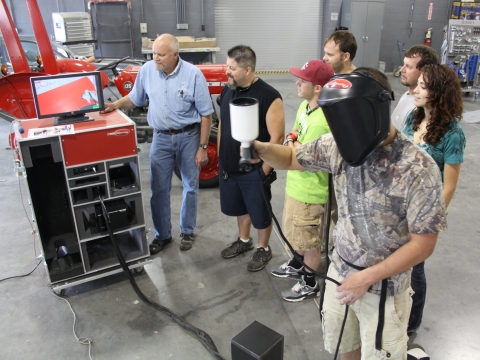Virtual Reality Goes to School
NO OVERSPRAY Using a SimSpray tool, a student at Randolph Community College in North Carolina practices his painting technique. Credit Randolph Community College.
THE blistering pace of advances in automotive technology may be confusing to consumers, but it seems to be creating a strong employment outlook for those who fix cars.
According to a forecast by the Bureau of Labor Statistics, from 2010 to 2020 the work force will add positions for 124,800 service technicians and mechanics, 32,700 automotive body and glass repairers and 13,800 painting and coating workers. While that growth rate is not explosive, the Labor Department foresees steady employment for those with training and certification.
But the rapid-fire technology developments are also widening the skills gap. Basic mechanical know-how is no longer enough; new materials, assembly processes and electronic controls make repair work more challenging. As a result, training has become more demanding, even as schools face tighter budgets and shorter classroom hours.
How will they train new technicians under such pressures? Video game technology may provide part of the answer.
“Time is not our friend,” said Ron Ussher, a collision-repair instructor at the Thomas A. Edison Career and Technical Academy at Elizabeth High School in Elizabeth, N.J., noting the pressure to teach more in fewer hours. “But with the simulator, time isn’t an issue.”
Last year, Mr. Ussher saw a demonstration of a new virtual-reality teaching tool called SimSpray, made by VRSim, a technology start-up in East Hartford, Conn., which helps students learn the basics of automotive painting. There was soon one in his school’s paint shop.
To use the simulator, a student works a realistic spray gun while a 3-D view of a spray booth is projected in the hood covering the student’s face. The simulator is what virtual-reality engineers call immersive, rendering a lifelike setting of a paint booth, providing cues to help students develop the muscle memory needed for a smooth paint job.
In the real world, painting requires costly materials and hours of preparation, but simulators put learning on a faster track, teachers say.
“You can make a mistake, redo it, then hit it again,” Mr. Ussher said. “We can do five paint jobs in 10 minutes.”
Speed is not the only advantage. According to a 2010 study conducted at Iowa State University, students training on a virtual welding machine were 30 to 40 percent more likely to gain professional certifications than those who trained exclusively in normal classroom and shop conditions.
“These simulators give enough fidelity that people can experiment,” explained Richard Stone, a 33-year-old professor of industrial and manufacturing systems engineering at Iowa State, and the study’s lead researcher.
VRSim developed the welding simulator in 2003 under a Defense Department grant; the units are now sold by Lincoln Electric, a Cleveland-based maker of welding machines, for $46,500. Customers include training schools, local trade unions, manufacturers and prisons.
SimSpray, introduced last year following the success of the welding unit, starts at $25,000.
Mastering the fine points of welding and painting is not easy. Last summer, I tried out the paint simulator. I had more confidence in this skill — I partly paid my college tuition sprucing up houses and apartments — but quickly learned that I was in need of a refresher. The trick to spray painting is keeping the spray gun head perpendicular to the working surface while maintaining a rhythm of smooth, consistent strokes.
As I painted a car’s fender in the virtual world, drips oozed down the surface where I applied too thick a coat, and patches of primer poked through thin spots.
Such teaching tools appeal to people who grew up playing video games, experts say. “You’ve got an aging work force, and they are still painting like they were painting in the ’60s and ’70s,” said Matthew Wallace, chief executive and president of VRSim. “This speaks in the language of the video-game generation.”
Simulators at job fairs are helping to inspire youths’ interest in the skilled trades, he said.
Schools using the training simulators are also saving money on materials and energy.
“We saved about $4,000 on fluid this semester that we were purchasing to teach these students gun technique,” said Dan Moore, who heads the collision-repair department at Randolph Community College in Asheboro, N.C. “It saved us a lot of money, and they get the gun technique down. We don’t let them in the paint booth until they can score 55 percent.”
A version of this article appears in print on May 20, 2012, on Page AU4 of the New York edition with the headline: Virtual Reality Goes to School.




